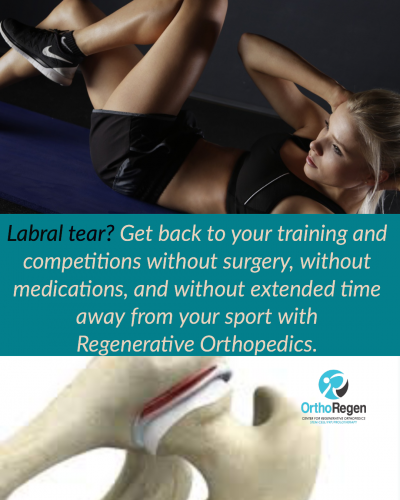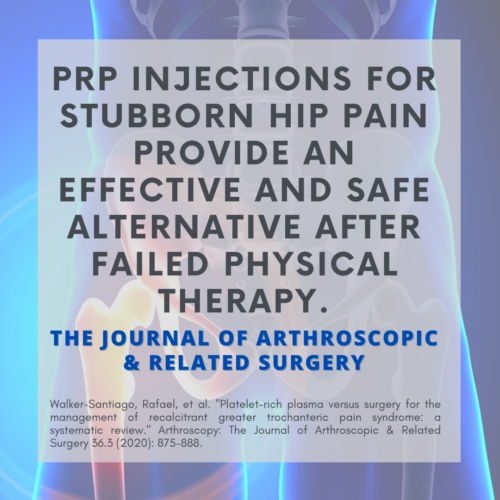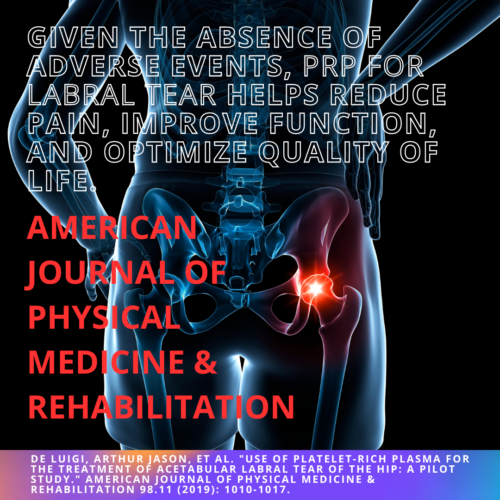Hip Labral Tear Treatment Options
Regenerative, non-surgical treatments for painful hip labral tears have grown in recent years and with good reason. People want an alternative to the invasiveness of surgery and options that do not require anesthesia or a hospital stay. They also want therapies known to have successful long-term results.
Regenerative Orthopedics can regrow cartilage and restore degenerated tissue so that decreased mobility and unrelenting hip pain from a hip labral tear can become a thing of the past. Being diagnosed with a labral tear of the hip no longer has to mean surgery, prolonged downtime, and giving up leisure activities.

The Hip and Labrum
The hip joint is a ball-and-socket joint with very large ligaments that usually keep the hip pretty stable, helping to prevent injuries. And the hip labrum is a ring of cartilage that seals the ball and socket, and aids in providing movement between the leg and pelvis.
But we move our hips a lot and put them through high rates of wear. So more and more, hip injuries, including tears to the labrum, are becoming a source of pain and disability. Additionally, the excessive force required in different sports activities can push the hip and its labrum beyond their normal range, resulting in injury.
The hip labrum also serves as a cushion and shock absorber to protect the hip and thigh bones. Damage or degeneration to the labrum will result in pain and instability of the hip joint. And labral tears can be caused by a sudden, specific injury or with repetitive motions that cause wear and tear type injuries.
Hip Labral Tear Symptoms
Symptoms include varying degrees of pain, including pain deep in the groin, as well as clicking, popping, and a locking sensation in the hip joint.
A labral tear in the hip destabilizes the hip joint and is associated with early onset arthritis. Overgrowth of bone will occur in an attempt to stabilize the area.
Let’s explain this arthritis connection further! The disrupted balance in motion that transpires after the original injury causes an uneven weight distribution inside the joint. And that prompts the joint surfaces to rub roughly and then generate a breaking down of articular cartilage. That limits joint function and promotes bone loss and the eventual bony overgrowth of arthritis.
Treatment Options for Hip Labral Tears
The labrum has a poor blood supply. And this makes a tear or injury difficult to treat with conservative approaches since they are unable to repair the injured ligaments, torn labrum, or the resultant instability and imbalance caused by the injury. Standard therapeutic approaches such as pain medications, steroid injections, and arthroscopy, employed to address labral injuries, are often ineffective. That’s because they are not reparative and do not heal the underlying cause of the problem, the injured ligaments, labrum, and hip instability.
Physical therapy can help strengthen the surrounding muscles. But it cannot repair the labrum or prevent further degeneration from the abnormal motion the injury has caused in the hip joint.

Surgical repair is also a common treatment for persistent hip pain. Is surgery always necessary? No! And is there a non-surgical alternative? Yes! PRP is an effective non-surgical option. The Journal of Arthroscopic and Related Surgery says, “Although significant improvement was reported in all studies included, PRP showed a large effect size whereas surgery showed a moderate to large effect size. No major complications were associated with PRP treatment; however, the surgery group reported a higher rate of complications including recurrent external snapping hip, retears resulting from falls, trochanteric fracture, venous thrombosis, and wound-related problems.” (1)
Pain Relief, Restoration of Hip Function and Stability with Regenerative Orthopedics
Regenerative Orthopedics aims to address the soft tissue weakness that transpired during the original hip labral tear injury. The treatment also restores the normal function of the labrum, correcting the imbalance, and stimulating repair where the degeneration has occurred.
Non-Surgical Regenerative Orthopedics, including Stem Cell Therapy, PRP, and Prolotherapy are alternative modalities that can repair the injury and abnormal joint motion by stimulating the natural regenerative processes in and around the hip joint. The torn labrum and the involved injured ligaments are restored to a healthy state, which improves joint support and function, and reduces pain and symptoms.
Degenerative conditions, such as hip labral tear injuries need regeneration. Regenerative Orthopedics repairs the labrum and supports the formation of cartilage in the hip environment. This regenerative therapy has been found effective for the treatment of labral injuries. And the non-surgical treatment involves the injection of natural substances into the degenerated hip to stimulate healing.
Cellular Therapies Such as PRP and Stem Cells
Prolotherapy is a regenerative injection therapy that should be highly considered for people suffering from chronic hip pain. All of our treatments include Prolotherapy because it strengthens and heals the injured soft tissue that is at the source of the painful hip condition. Sometimes in the treatment of labral tears, cellular therapies such as
PRP and
Stem Cells are also needed. Especially in very active people and athletes, or in conditions with more severe degeneration. These therapies involve the injection of an autologous preparation (from a person’s own blood, fat or bone marrow). The solution is then injected directly into the damaged joint, to accelerate the healing process in more severe cases of labral injury. The surrounding soft tissue would also be treated comprehensively.

Research shows that Regenerative Orthopedics, like PRP, are successful non-surgical options for hip labral tears. The American Journal of Physical Medicine says, “Given the absence of adverse events,…PRP for labral tear helps reduce pain, improve function, and optimize quality of life.” They also say, “Platelet-rich plasma holds promise as an emerging, minimally invasive technique toward symptom relief, reducing pain, and improving function in patients with hip labral tears.” (2)
We recommend this choice before considering surgery since surgical removal of the labrum will make the joint more unstable. And surgery will limit labrum flexibility by stapling part of it down, making it even more susceptible to tears and future degeneration.
Most painful hip conditions begin with damage to the surrounding ligaments. And they progress into degenerative conditions like labral degeneration. Since the hip labrum along with the surrounding ligaments, provide most of the stability of the hip, all of these areas need to be treated. We have treated hip labrum tears successfully for many years at OrthoRegen®, and offer an effective and much-needed alternative to hip surgery in cases of hip labral tears.
References
(1) Walker-Santiago, Rafael, et al. “Platelet-rich plasma versus surgery for the management of recalcitrant greater trochanteric pain syndrome: a systematic review.” Arthroscopy: The Journal of Arthroscopic & Related Surgery 36.3 (2020): 875-888.
(2) De Luigi, Arthur Jason, et al. “Use of platelet-rich plasma for the treatment of acetabular labral tear of the hip: a pilot study.” American journal of physical medicine & rehabilitation 98.11 (2019): 1010-1017.
Click here for more articles


